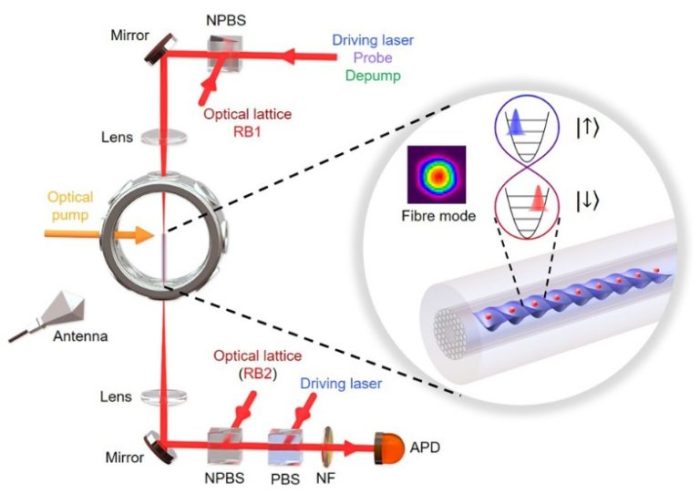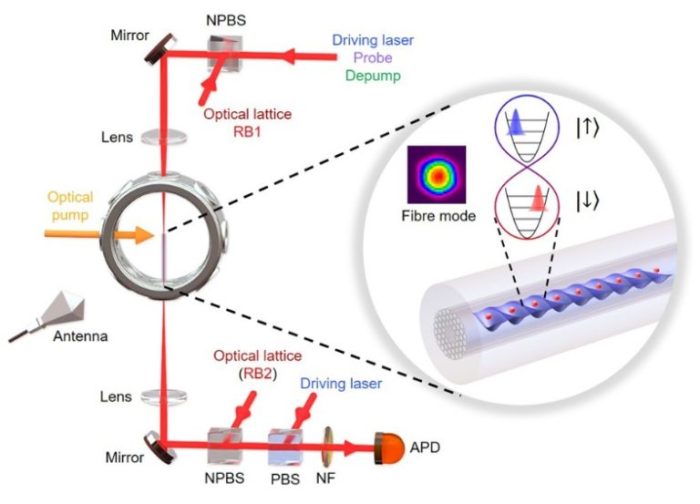UK scientists create robust optic fiber that may unlock quantum future – this groundbreaking development could revolutionize communication and computing. Imagine a world where information travels at lightning speed, where data is unhackable, and where computers solve problems that are currently impossible.
This is the promise of quantum computing, and a new type of optical fiber is bringing us closer to this reality.
Researchers at the University of Bristol have created a new type of optical fiber that is specifically designed to carry quantum information. This fiber is more robust than previous versions, meaning it can transmit quantum signals over longer distances with less loss.
This is a major breakthrough, as it overcomes one of the biggest challenges in building quantum networks: the fragility of quantum information.
Introduction to Quantum Computing

Quantum computing is a revolutionary technology that harnesses the principles of quantum mechanics to perform computations in ways that are impossible for classical computers. Unlike classical computers that rely on bits, which can be either 0 or 1, quantum computers utilize qubits.
Qubits can exist in a superposition of states, meaning they can be both 0 and 1 simultaneously. This unique property allows quantum computers to process information exponentially faster than classical computers for certain types of problems.The potential impact of quantum computing on various fields is immense.
It could revolutionize drug discovery, materials science, financial modeling, artificial intelligence, and cryptography. For example, quantum computers could accelerate the development of new drugs by simulating complex molecular interactions, leading to more effective treatments for diseases. In materials science, quantum computers could help design novel materials with enhanced properties, such as improved conductivity or strength.
Challenges and Limitations in Quantum Computing
Quantum computers are still in their early stages of development, and several challenges and limitations hinder their widespread adoption. One major challenge is maintaining the delicate quantum states of qubits. Qubits are extremely sensitive to environmental noise, such as temperature fluctuations or electromagnetic interference, which can cause them to lose their quantum properties.
This phenomenon, known as decoherence, limits the time qubits can maintain their superposition state, thereby restricting the complexity of computations that can be performed.Another challenge is the scalability of quantum computers. Building quantum computers with a large number of qubits is a complex engineering feat.
Do not overlook the opportunity to discover more about the subject of european automobile industry is going quantum.
As the number of qubits increases, the complexity of controlling and connecting them grows exponentially. Additionally, the cost of building and operating quantum computers is currently very high, making them inaccessible to most researchers and companies.
Significance of Robust Optical Fiber in Quantum Networks
Robust optical fiber plays a crucial role in enabling the development of quantum networks, which are essential for connecting and sharing quantum information between different locations. Quantum networks rely on the transmission of entangled photons, which are pairs of photons that are linked together in a way that allows them to share information instantly, regardless of distance.Optical fiber provides a reliable and efficient way to transmit these entangled photons over long distances with minimal loss.
The development of robust optical fiber that can withstand environmental factors, such as temperature changes and vibrations, is essential for ensuring the integrity and stability of quantum networks.
The New Optical Fiber Development
This breakthrough in fiber optics, spearheaded by UK scientists, represents a significant leap forward in the field of quantum communication. The newly developed fiber possesses unique properties that make it significantly more robust and suitable for transmitting quantum information, paving the way for a future where quantum computers can communicate securely and efficiently.
Key Features and Advancements
The new fiber, unlike traditional optical fibers, is designed to minimize the loss of quantum information during transmission. This is achieved through several key features:
- Reduced Scattering:Traditional optical fibers can scatter light, leading to the loss of quantum information. The new fiber minimizes this scattering by incorporating a special glass core with a highly uniform refractive index. This ensures that light travels through the fiber with minimal deviation, reducing the loss of quantum information.
- Enhanced Transmission Efficiency:The new fiber is designed to transmit light with minimal attenuation. This is achieved through a special coating that reduces the absorption of light by the fiber’s cladding. This ensures that quantum information can be transmitted over longer distances with minimal degradation.
- Improved Stability:The new fiber is designed to be highly stable, ensuring that quantum information can be transmitted without distortion. This is achieved through a special process that strengthens the fiber’s core, making it less susceptible to environmental fluctuations and vibrations.
Properties for Quantum Communication
The robust nature of the new fiber makes it ideal for quantum communication. Here’s how:
- Reduced Noise:Quantum information is extremely fragile and susceptible to noise. The new fiber, with its reduced scattering and enhanced transmission efficiency, minimizes the introduction of noise during transmission, preserving the integrity of quantum information.
- Long-Distance Transmission:The ability to transmit quantum information over long distances is crucial for the development of a quantum internet. The new fiber, with its improved stability and minimal attenuation, allows for the transmission of quantum information over significantly longer distances compared to traditional optical fibers.
- Secure Communication:Quantum communication is inherently secure, as any attempt to intercept or eavesdrop on quantum information will inevitably introduce noise, making it detectable. The new fiber’s robustness further enhances security by minimizing the introduction of noise from external sources, ensuring that quantum communication remains secure even over long distances.
Comparison to Existing Optical Fibers
The new fiber represents a significant departure from existing optical fibers used in traditional communication networks. Here’s a comparison:
| Feature | Traditional Optical Fiber | New Quantum Fiber |
|---|---|---|
| Light Scattering | High | Low |
| Transmission Efficiency | Moderate | High |
| Stability | Moderate | High |
| Noise Sensitivity | High | Low |
| Quantum Information Loss | High | Low |
| Transmission Distance | Limited | Extended |
Implications for Quantum Networks: Uk Scientists Create Robust Optic Fiber That May Unlock Quantum Future
The development of this robust optical fiber represents a significant step towards realizing the potential of quantum networks. These networks leverage the principles of quantum mechanics to enable secure and high-speed communication, surpassing the limitations of traditional networks.
Secure Communication
Quantum networks offer unparalleled security for communication, thanks to the inherent properties of quantum mechanics. Quantum cryptography techniques, such as quantum key distribution (QKD), rely on the fundamental principles of quantum entanglement and superposition to generate secure keys that are virtually impossible to intercept or tamper with.
This robust encryption ensures that sensitive information remains confidential, even when transmitted over long distances.
- QKD utilizes entangled photon pairs, where the measurement of one photon instantly influences the state of its entangled partner, even if they are physically separated. This unique property ensures that any attempt to eavesdrop on the communication channel will be detected, guaranteeing the integrity of the shared key.
- Quantum networks can significantly enhance the security of financial transactions, sensitive data transfers, and military communications. By utilizing QKD, these networks can safeguard critical information from cyberattacks and ensure the confidentiality of sensitive data.
Applications in Scientific Research
Quantum networks will revolutionize scientific research by enabling unprecedented collaboration and data sharing. Researchers across different institutions and geographical locations can connect and share quantum information, leading to breakthroughs in fields such as:
- Fundamental physics:Quantum networks will facilitate the exploration of complex quantum phenomena, such as quantum entanglement and superposition, paving the way for new discoveries in fundamental physics.
- Materials science:By enabling the remote control and manipulation of quantum systems, researchers can investigate the properties of materials at the atomic level, leading to the development of novel materials with advanced functionalities.
- Drug discovery:Quantum networks can accelerate drug discovery by enabling the simulation of complex molecular interactions, leading to the development of more effective and targeted therapies.
Potential Benefits for Society and the Economy
The widespread adoption of quantum networks will have profound implications for society and the economy, leading to:
- Enhanced cybersecurity:Quantum networks will bolster cybersecurity by providing unbreakable encryption, safeguarding sensitive data and critical infrastructure from cyberattacks. This will create a more secure and resilient digital environment for individuals, businesses, and governments.
- Innovation and economic growth:Quantum networks will foster innovation and economic growth by enabling new technologies and applications across various sectors. This will lead to the creation of new industries, jobs, and economic opportunities.
- Improved healthcare:Quantum networks will revolutionize healthcare by enabling the development of new diagnostic tools and treatments, leading to more effective disease prevention and treatment strategies. This will improve patient outcomes and enhance overall well-being.
Future Research Directions
While this new robust optical fiber marks a significant advancement in quantum communication, several challenges remain before widespread deployment of quantum networks becomes a reality. Further research and development are needed to overcome these hurdles and unlock the full potential of this technology.
Addressing Remaining Challenges, Uk scientists create robust optic fiber that may unlock quantum future
The development of quantum networks faces several critical challenges. Addressing these challenges is crucial for the successful implementation and deployment of these networks.
- Loss and Noise:Quantum signals are extremely fragile and susceptible to loss and noise during transmission. This limitation restricts the distance over which quantum information can be reliably transmitted. Researchers are exploring techniques like quantum repeaters and error correction codes to mitigate these effects.
- Scalability:Building large-scale quantum networks requires efficient and scalable methods for connecting multiple quantum nodes. This includes developing scalable quantum memories, entanglement distribution protocols, and efficient routing algorithms.
- Integration and Compatibility:Integrating quantum communication systems with existing telecommunication infrastructure is essential for seamless deployment. This requires research into compatible technologies and protocols that can bridge the gap between classical and quantum networks.
Advancements in Optical Fiber Technology
Continuous advancements in optical fiber technology can significantly enhance quantum communication capabilities.
- Improved Fiber Design:Developing fibers with lower loss and reduced noise levels is crucial for extending the reach of quantum networks. This includes exploring novel fiber materials and manufacturing processes.
- Multiplexing Techniques:Utilizing multiplexing techniques can increase the information carrying capacity of optical fibers. This allows for transmitting multiple quantum signals simultaneously, enhancing the efficiency and capacity of quantum networks.
- Integrated Photonics:Integrating optical components directly onto the fiber can reduce loss and improve the overall performance of quantum communication systems. This approach holds promise for developing compact and efficient quantum devices.
Impact of Research Areas
The following table summarizes key research areas and their potential impact on the advancement of quantum networks:





